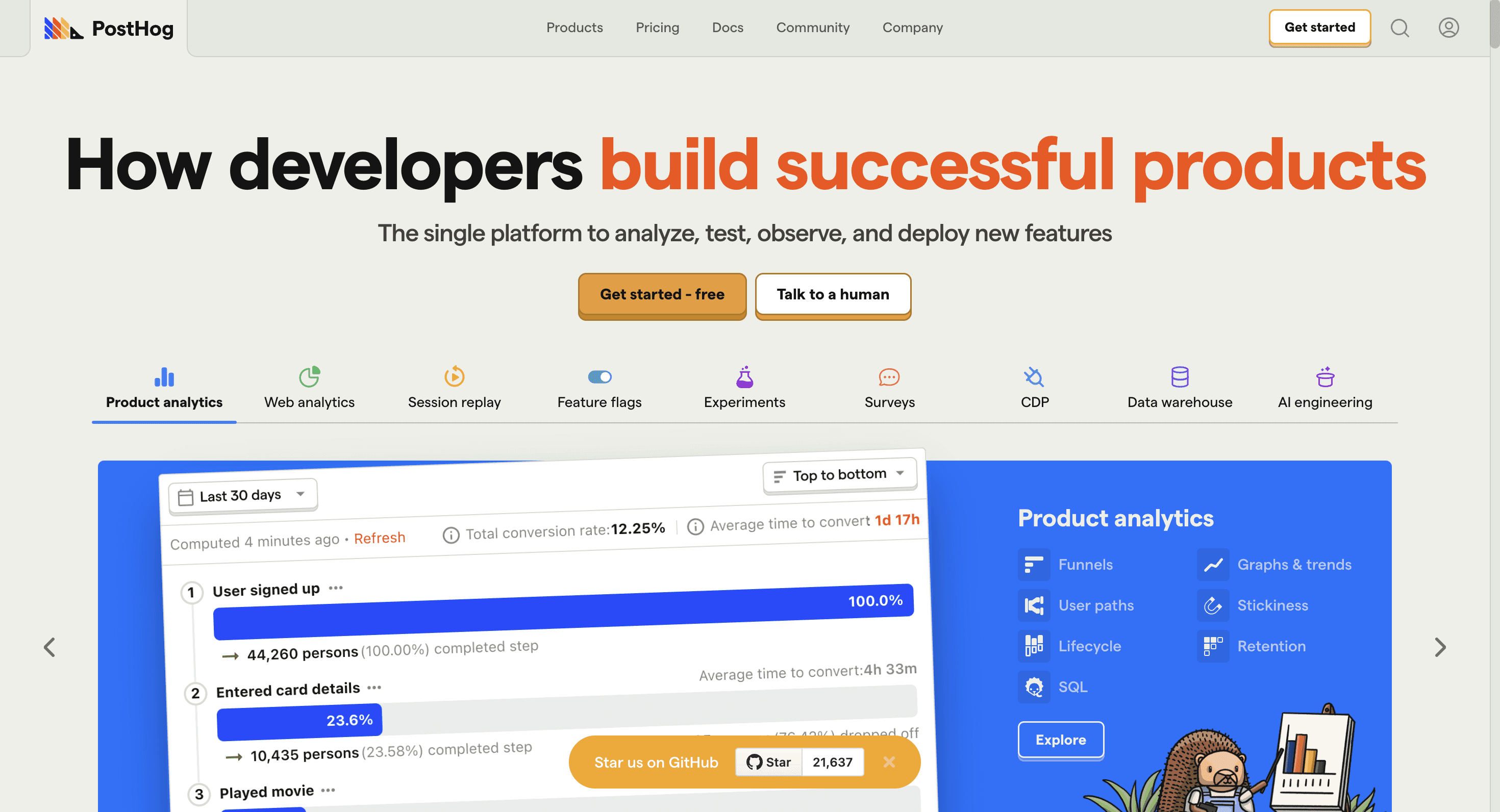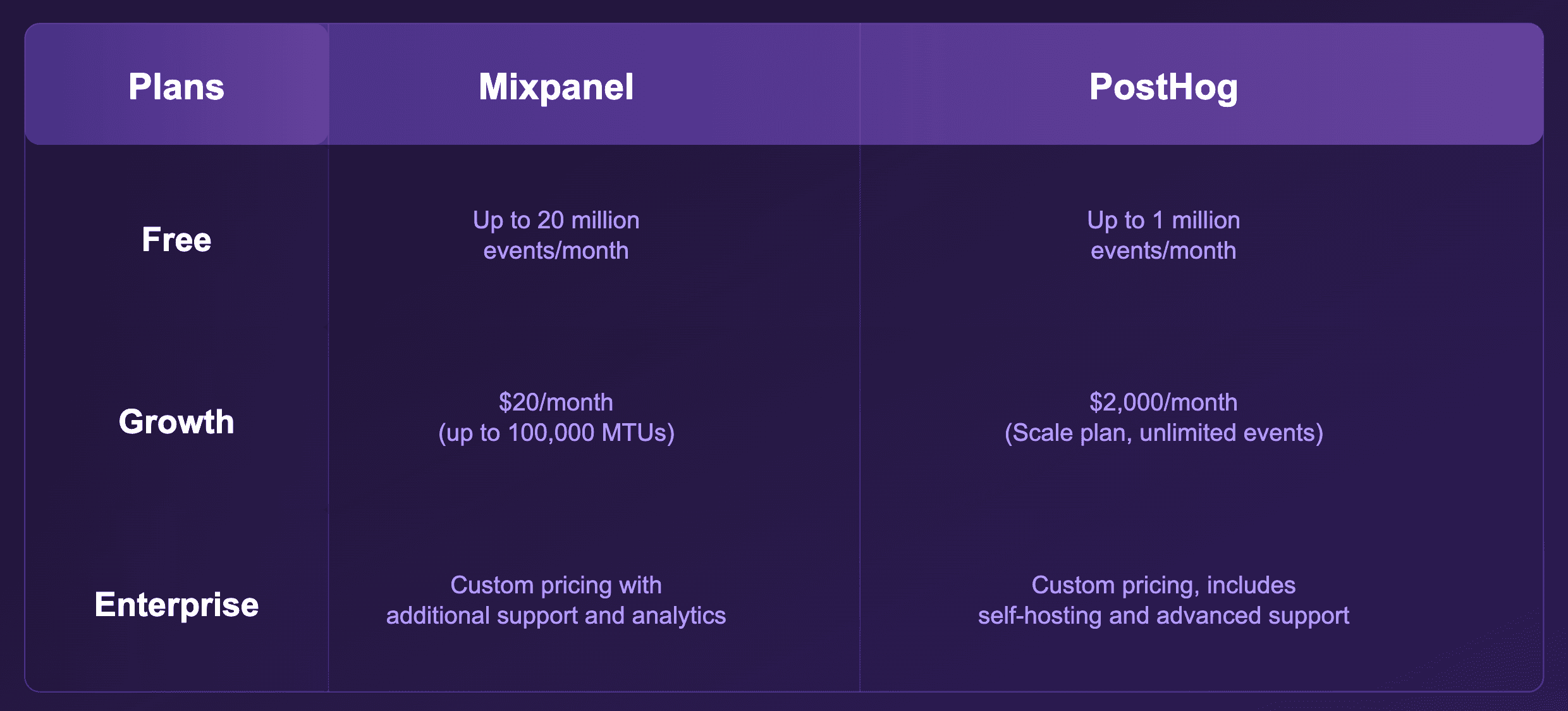
Analyzing Customer Retention: Mixpanel vs. PostHog

by
Wiktoria Slowikowska
Oct 28, 2024
Identify and convert your most valuable users
Sign Up
Customer retention plays a critical role in sustainable growth. Acquiring a new customer is often more costly than retaining an existing one, making retention metrics crucial for any business aiming for long-term profitability. Analytics platforms like Mixpanel and PostHog offer features specifically designed to measure, analyze, and improve customer retention.
In this article, we’ll explore these two platforms, focusing on the tools and features they offer to boost retention, comparing their pricing structures, and discussing which platform is better suited for various retention strategies.

Mixpanel

Overview
Mixpanel is a sophisticated product analytics tool focused on user engagement, behavior tracking, and retention. Known for its ease of use and rich feature set, Mixpanel is popular among SaaS, e-commerce, and digital product companies aiming to foster long-term user engagement. With an emphasis on event-based tracking, Mixpanel provides insights into user behaviors that correlate with retention and enables teams to make data-driven improvements.
Key Retention Features

Retention Cohort Analysis: Mixpanel’s retention reports allow companies to track how often users return and re-engage over time, based on specific actions or events.
Funnel Analysis: Through its funnel analysis, Mixpanel helps identify drop-off points within key user flows—like onboarding or checkout processes—enabling teams to make targeted improvements.
Behavioral Cohorts: Mixpanel’s cohort analysis allows segmentation of users based on behaviors, such as frequently engaging with specific features. This helps businesses understand user journeys and retain valuable user segments.
A/B Testing: By enabling experimentation, Mixpanel lets teams test product changes, such as UI adjustments or new features, and measure their impact on retention and user satisfaction.
Pricing
Free Plan: Offers up to 20 million monthly events, a substantial threshold for small businesses exploring Mixpanel’s basic features.
Growth Plan: Starts at $20/month, offering enhanced reporting and analytics, suited for businesses needing more advanced cohort and retention data.
Enterprise Plan: Provides custom pricing for large organizations, including priority support, custom analytics, and dedicated account management.
Mixpanel Reviews:

PostHog

Overview
PostHog is an open-source analytics platform designed for companies that need deep customization and data control. Unlike most analytics tools, PostHog can be self-hosted, allowing organizations full ownership of their data—a significant advantage for businesses with stringent data privacy requirements. PostHog’s features, particularly its custom tracking capabilities, cater to companies that prioritize retention and want to tailor their analytics to specific business needs.
Key Retention Features

Retention Analysis: PostHog’s retention analysis allows businesses to monitor user return rates over defined periods, which can provide clear insights into user loyalty and feature engagement.
Path Analysis: PostHog offers path analysis to map out user journeys within a product, helping businesses identify common workflows, points of confusion, or areas where users might drop off.
Customizable Funnels and Dashboards: With PostHog, businesses can set up custom funnels and dashboards tailored to their specific retention KPIs, creating highly specific data visuals to analyze user behavior in detail.
Feature Flags: PostHog includes a feature-flagging system that lets businesses experiment with new features in a controlled manner, providing insights into how these changes impact retention without a full-scale deployment.
Pricing
Free Plan: Covers up to 1 million events per month, making it a great starting point for smaller teams with essential analytics needs.
Scale Plan: Starts at $2,000/month for unlimited events and additional support, ideal for businesses looking to scale.
Enterprise Plan: Offers custom pricing for larger companies, including self-hosting options, advanced support, and custom integrations.
Posthog Reviews:

Comparing Key Retention Features
1. Retention Cohort Analysis
Mixpanel: Mixpanel’s cohort analysis enables businesses to track specific user groups and measure engagement trends over time. By analyzing cohorts, companies can identify which user behaviors correlate with higher retention rates and determine the stages where users are most likely to drop off.
PostHog: PostHog’s cohort analysis is similar but offers more customization and flexibility, particularly for self-hosted data setups. Businesses can track user retention based on unique events and intervals, making it especially useful for companies with complex user journeys or distinct customer segments.
2. Funnel Analysis and Drop-Off Tracking
Mixpanel: Known for its detailed and intuitive funnel analysis, Mixpanel allows teams to identify points of friction in important user flows, like onboarding and checkout. This data can guide improvements that keep users engaged and reduce churn.
PostHog: PostHog also provides robust funnel tracking but with additional flexibility due to its open-source structure. Businesses can define custom funnels and set specific tracking parameters to pinpoint exact areas of interest or concern in the customer journey.
3. Path Analysis for Retention Optimization
Mixpanel: Mixpanel’s path analysis visualizes common routes users take within a product, providing insight into how users interact with various features and where they might exit. This helps teams make product improvements based on high-engagement paths.
PostHog: PostHog’s path analysis is highly customizable, allowing companies to adjust settings to focus on specific retention-critical interactions. This feature is particularly valuable for identifying pathways that lead to higher engagement or higher retention rates in self-hosted environments.
4. Experimentation and Feature Rollouts
Mixpanel: With A/B testing functionality, Mixpanel allows companies to test different versions of a feature, interface, or flow to understand which changes positively impact retention. This functionality is crucial for making data-backed product decisions.
PostHog: PostHog’s feature flags provide a controlled rollout option, allowing teams to release features gradually and assess their impact on retention. This is beneficial for managing gradual product rollouts or updates in high-stakes environments where user feedback is essential.
Key Differences in Retention Strategies
1. Data Control and Deployment Options
Mixpanel: As a cloud-based tool, Mixpanel is best for businesses comfortable with third-party data hosting. Its extensive pre-built reports and robust cloud-based storage make it easy for companies to analyze user behaviors quickly.
PostHog: Offering both self-hosted and cloud options, PostHog is ideal for companies requiring full control over their data due to privacy or compliance reasons. Self-hosting also allows for deeper customization, making it preferable for businesses with in-house technical resources.
2. Customization and Product Flexibility
Mixpanel: While highly customizable within the platform, Mixpanel is built as a cloud tool and offers straightforward, powerful retention reports. It’s best suited for teams that need a ready-to-use platform with robust out-of-the-box retention metrics.
PostHog: Built as an open-source solution, PostHog offers extensive flexibility for businesses that need to tailor the platform. With custom path analysis, tracking, and feature deployment options, PostHog is ideal for companies that want to align the tool with specific retention goals and data structures.
Detailed Pricing Comparison

Mixpanel’s pricing is based on Monthly Tracked Users (MTUs), which aligns well for growing SaaS companies and digital platforms that want granular insights at different scales. PostHog’s pricing is structured around event volume and customization needs, making it more suited to businesses that require data ownership and complete control over analytics configurations.
Choosing the Right Tool for Your Retention Strategy
Both Mixpanel and PostHog provide valuable tools for analyzing and improving customer retention, but each has a distinct approach that serves different types of businesses:
When to Use Mixpanel:
If your team prioritizes cloud-based analytics with minimal setup.
If your focus is on understanding detailed user journeys and drop-off points for a SaaS or digital product.
If you need ready-made retention reports and analysis without extensive customization.
When to Use PostHog:
If data control and ownership are priorities for your organization.
If you need an open-source solution that allows in-depth customization, ideal for companies with in-house engineering resources.
If your product relies on experimentation and controlled rollouts to optimize retention-sensitive features.
Conclusion
Mixpanel and PostHog are both powerful tools for analyzing and improving customer retention, but their unique features cater to different business needs. Mixpanel is best suited for companies seeking a streamlined, cloud-based tool for tracking user engagement and retention, while PostHog is designed for organizations needing maximum control over their data and custom analytics capabilities.
Selecting the tool that aligns with your data needs and retention goals will allow you to make informed, data-driven decisions, helping your business foster lasting relationships with its customers and drive long-term growth. Whether through Mixpanel’s intuitive A/B testing or PostHog’s flexible feature flags, both platforms offer powerful solutions to enhance customer loyalty and engagement.




